Tau Ceti: Difference between revisions
Tablespoon (talk | contribs) |
|||
| (63 intermediate revisions by 19 users not shown) | |||
| Line 1: | Line 1: | ||
{{Navbox Lore}} | |||
{{Navbox Human Lore}} | |||
''' | [[File:TAU CETI (1).png|thumb|500px|An image depicting Tau Ceti.]] | ||
'''Tau Ceti''' is one of the most populous systems of humanity, located only twelve light years from [[Sol]]. It is the current capital system of the [[Republic of Biesel]], and prior to 2462 was the only territory controlled by the Republic. It became independent from the [[Sol Alliance]] in 2452 as a result of the [[Megacorporations|megacorporation]] [[NanoTrasen]], and the monopoly it had on the precious resource known as phoron, which was discovered in the system itself. | |||
Tau Ceti was first settled in 2147, after a colony ship touched down on the planet [[Biesel]]. From there, a base on the moon of [[Valkyrie]] was established, and significant colonization efforts also went underway on the planet of [[New Gibson]]. In the modern day, it is the richest system and one of two centers of trade in the [[Orion Spur]], almost all of which can be attributed to the system having one of the largest deposits of Phoron in the known Spur within its Romanavich Cloud. Since the beginning of the scarcity however, these deposits have begun to dry up at an exponential rate, and the system has begun to face many issues(hyperlink to Republic of Biesel page, Scarcity section). | |||
{{TOC Hidden}} | |||
==Planets and Major Bodies== | |||
=== Tau Ceti === | |||
The orbit of the star itself is one of the most heavily trafficked areas within human space, as it is where the massive Bluespace Ring present in the system is situated. There is a constant stream of incoming and outgoing traffic, all who pay a toll to the Republic, though sometimes they may not stay in the system for more than a few hours. That said, a vast majority do end up heading into the system itself, normally ending up in orbit of [[Biesel]], [[New Gibson]], or most commonly, [[Valkyrie]]. | |||
=== | === [[Caprice]] (Tau Ceti I) === | ||
''' | [[File:Caprice2.png|thumb|left|A map of the planet Caprice and its largest settlements.]] | ||
From the surface, Caprice is a scorching-hot volcanic planet in Tau Ceti. It is dotted with small research outposts and jagged artificial ravines, not unlike the innumerable near-identical mining colonies spread throughout the Spur. This surface appearance has, since the arrival of the [[Zo'ra in the Republic of Biesel|Zo'ra Hive]] upon it a short decade ago, become deceptive and now hides Caprice's true nature. | |||
Anyone who dares to peel back and look beneath the folds of crust and bedrock finds not empty caverns and pits of magma but instead an immense subterranean metropolis of stone, steel, and flesh. Its Vaurcaesian design harkens back to the golden age of the Zo'rane Empire over Sedantis. | |||
'' | The Zo'ra, under [[Vaur, The Liminal Queen|High Queen Vaur]] and [[Zoleth, The Herald of Scars|Queen Zoleth]], have labored endlessly to turn what was only a short time ago an inhospitable wasteland into a true seat of not just her power but the new home of the Court of Queens to represent Vaurca across the Spur. It is from the newly ordained capital and seat of her throne, New Sedantis, that this mighty project began, but it certainly has not stopped there. Tunnels stretch all the way to the equally mighty Zo'rane fortress of Dis and even further beyond, deep towards the core. If the High Queen has her way, this construction has no plans to slow down anytime soon, phoron crisis or not. | ||
Luthien | === Luthien (Tau Ceti II) === | ||
[[File:luthien.jpg|thumb|245px|One of the numerous research outposts around the Luthien northern sea.]] | |||
Luthien is a desert planet with a thin, unbreathable atmosphere of primarily nitrogen, and is not so much a colony as it is a factory. It is primarily home to Vaurcae from the brood of [[Xakt, Queen of Corpses]], with most Workers being Bound Vaurcae. Some Unbound Vaurcae reside within the small settlements of human scientists and other interested parties that live upon the surface of the planet. | |||
Luthien is the site of many testing and research facilities, such as those dedicated to weapons testing for the TCAF, or the development of flora and fauna that are able to adapt to extreme environments. Notably, k'ois is grown in select areas on the surface, far from the human-inhabited poles. Many areas of the desert planet can now be distinguished by their uncanny yellow sheen as the fungus grows just barely in control, twisting through and even under the dunes. While bouts of mycosis are uncommon, several high-profile incidents have led to some strife with the human populace and medical presence being on constant standby. | |||
' | |||
' | On the other hand, some research teams have found cooperation to be of value with the Zo'ra, allowing them to work in their laboratories scattered throughout the planet. Non-Vaurcae find that the Unbound can be relied on to keep secrets, and are invaluable for their VR and general scientific ability. The Au'takh of the [[Aut'akh#The_Luthien_Pact,_"the_Pacters"|Luthien Pact]] also work closely with the megacorporations, granting them a better quality of life than many of their kin elsewhere in the Republic - though at the cost of their prized freedom. | ||
=== [[Biesel]] (Tau Ceti III) === | |||
[[File:biesel3.jpg|thumb|left|245px|The cityscape of Mendell City, displaying Biesel's high level of urban development.]] | |||
The third closest planet to Tau Ceti's star, Biesel is an Earth-like planet that benefits from a temperate climate and breathable atmosphere. Water represents 56% of the planet's surface. | |||
Biesel is | Biesel is the most populous planet within the system, having many large cities and urban developments; it also serves as the capital planet for the [[Republic of Biesel]]. Environmental pollution remains low, primarily thanks to technologies developed during the [[Technology|phoronic revolution]]. The landmass of the planet itself is split into three massive continents, Astraeus, Selene and Eos; each hosting a multitude of cities and a continental capital. The capital of Biesel, and the Republic as a whole, is [[Mendell City]], a megalopolis on the southern coast of the northern continent of Astraeus. The orbit around the planet is extremely crowded, with many multipurpose space stations, shipyards, and defense platforms in permanent orbit, and thousands of ships passing through a day, alongside tens of thousands of shuttles. In a high orbit around the planet is [[NanoTrasen|NanoTrasen's]] former Tau Ceti Branch Central Command Platform, the once NTCC [[Odin]], recently renamed the SCCTCC Odin, alongside more stations than one can count. | ||
Biesel is primarily a financial, phoronics, and agricultural centre, with most of its citizens working in its service industry, followed closely by the phoronics industry. Biesel has the most phoronics related industries of anywhere in the Spur, primarily centered on the formerly mineral rich continent of Eos. As the scarcity increases, more and more of this industry is shuttered, [[Biesel|causing problems for the planet.]] Trade is also a major source of income, but a declining one, [[Phoron|as the scarcity increases the costs of running operations.]] Tourism remains somewhat profitable, with visitors being drawn to Biesel's sprawling shopping centres and national parks alike. | |||
====[[Valkyrie]]==== | |||
' | The moon of Biesel, the Commonwealth of Valkyrie is a member-state of the Republic that contributes strongly to its economy through its status as a major shipping and trade port. Valkyrie's smaller mass means ships will use less fuel getting in and out of orbit compared to its parent planet. Goods from all over the Spur, legal and illegal, can be found in the twisting streets of Valkyrie, and it acts as a layover for many tourist vessels and trade ships moving across the galaxy. However, in recent years, [[Valkyrie|it has developed a shadier reputation]], as more and more illegal goods [[Valkyrie|are smuggled through the port to be sold on Black Markets.]] | ||
New Gibson | === [[New Gibson]] (Tau Ceti IV) === | ||
[[File:newgibson.jpg|thumb|245px|New Gibson's capital, the Hengsha Arcology]] | |||
An ice covered world just outside the outer edge of the habitable zone, [[New Gibson]] is the industrial powerhouse of [[Tau Ceti]], home to almost all of its manufacturing. As the atmosphere on New Gibson is too thin to support life, all of its population lives under biodomes. | |||
The planet was a prime location for industrial development, since minimal terraforming was required, and populations of workers could be sustained in biodomes scattered across the barren landscape. Any activity on the planet's surface requires EVA equipment, but due to its high level of industrial development, the planet is the largest producer of consumer appliances, ship components, space station modules, and other manufactured goods in Tau Ceti. However it has very little phoronics industry, with most [[Biesel|being on the planet of Biesel.]] Instead, there is a steady stream of supply ships running between Biesel and New Gibson, supplying Tau Ceti’s industrial center with all the processed phoron and phoron compounds it needs for manufacturing. | |||
The planetary capital of New Gibson is the [[Arcology|Hengsha Arcology]], or simply Hengsha, a self-contained complex mimicking the landscape of Biesel, complete with parks, waterfalls and wildlife. While New Gibson has complex(s) dedicated to virtually all industries, its major players are advanced manufacturing with some wide-range manfacturing adjacent to its titanic planetary mines. In the cavernous pitfalls and valleys of New Gibson resides both its thriving mining economy - though the planet still must import many materials to meet manufacturing demands - and its greatest dangers. | |||
Reade | === Reade (Tau Ceti V) === | ||
Originally assumed to be a nondescript planet to 21st century astronomers, Reade defied expectations when early explorers found it to actually be a modestly sized gas giant. Its atmospheric composition mostly consists of hydrogen and helium, with heavier elements near the core. It takes 98 years for Reade to complete an orbit around the star, and has a few asteroid-sized moons. | |||
''' | Reade was previously most noteworthy for being the home of '''Anemostrovilos''', a massive reinforced blimp holding a platform with a radius of 19 kilometers. The bio-dome city of Anemostrovilos is built on top of this platform, and a massive anchor keeps the entire structure steady as it floats in Reade's upper atmosphere. Its local economy was a mix of harvesting the gasses from Reade, as well as serving students of the [[Human Educational Institutions#Anemostrovilos College of Pioneers|Anemostrovilos College of Pioneers]] for decades. | ||
However, since the independence of the system, Reade has slowly become the home of military shipbuilding in the Republic. While much of their pre-existing infrastructure was damaged [[KOTW|during the attack on Biesel by the 35th Fleet]], investments made by Hephaestus Industries - subsidized by a strategic diversification and economic relief program - have seen its military shipyards balloon in size. Recently, Hephaestus Industries completed work on the Republic Orbital Assembly Yards, an advanced military shipyard the likes of which the Republic has never had. As the budget for the [[TCAF]] only continues to [[Republic of Biesel|increase]], Reade only continues to see more business. | |||
The colony is buffeted by intense storms every few years due to its rotations around the gas giant, and periodically faces traffic shut-downs for up to 3 days at a time at least once a year. It has recently been heavily fortified by the [[Tau Ceti Armed Forces]], and the space around it has a significant military presence. While at one point Reade's orbit pirate activity enjoyed a massive spike and many unwary ships suffered, the increased strategic importance of Reade has seen the Republican Navy drive almost all but the most dedicated out of the inner system. | |||
=== | === Chandras (Tau Ceti VI) === | ||
Chandras is an icy body in a distant orbit of Tau Ceti. Although its surface contains lakes of liquid nitrogen, it is entirely metal-deficient, and possessing no infrastructures to speak of, is uninhabited and of low interest for the system. | |||
' | === The Dust Belt === | ||
Past Chandras, the Dust Belt is a thick ring of debris encircling Tau Ceti's solar plane and enclosing its inner planets. Debris varies in size ranging from microscopic dust particles to large asteroids the size of small moons. In the early days of colonization the belt was once a hive of mining activity, but was mined out by 2390 to provide materials for the booming populations of Biesel and New Gibson. Now it is home to mothballed facilities, and rumored corporate blacksites. | |||
[[File:4.jpg|thumb|245px|A NanoTrasen probe surveys an asteroid of the Romanovich Cloud, in search of Phoron deposits.]] | |||
=== Dumas (Tau Ceti VII) === | |||
Dumas is an extremely small rocky body that orbits at the far reaches of Tau Ceti - obscured almost entirely from the inner system by the dust belt - with one of its defining features is an almost complete lack of light, resulting in surface temperatures nearing absolute zero. Since the formation of the TCAF, however, it has [[Tau_Ceti_Armed_Forces#Installations|become one of the Republic’s largest military installations.]] | |||
=== The Romanovich Cloud === | |||
The Romanovich Cloud is a shell of icy, rocky and metallic bodies on the very edge of Tau Ceti’s gravity well. The cloud is the largest known source of [[Sandbox-Scarcity:Phoron|Phoron]], and has been mined for over a century, providing over ninety-five percent of all the phoron used in the Spur outside of [[Elyra]]. It is under the complete control of [[NanoTrasen]], keeping the corporation as one of the most powerful entities in the Orion Spur. The Romanovich Cloud is a hotbed for anomalous activity — which has only been steadily increasing as phoron deposits have dwindled. | |||
The Romanovich Cloud is a shell of icy, rocky and metallic bodies | |||
[[Category: | ==== Notable Locations ==== | ||
*'''NSS Aurora:''' founded in 2459 by [[NanoTrasen]], the NSS Aurora is a station built to replace its eponymous predecessor. Situated in a phoron-rich asteroid, the Aurora was responsible for mining and researching the valuable mineral. Due to the importance of the Romanovich Cloud, the station was the site of important events related to Tau Ceti, including the latest [[KING OF THE WORLD|Solarian invasion]]. The crew did not live on-site and commuted between the facility and the Odin during shifts. As phoron deposits began to dry up, the NSS Aurora's importance quickly diminished. A share of its crew was transferred to the [[SCCV Horizon]]. The station remains open and is mainly used to scrap whatever minerals are left in its foundations. | |||
*'''Grand Romanovich Casino:''' opened in 2462, the Grand Romanovich is a [[Crevus|Crevan]]-style casino floating in a touristic zone of the cloud. It was the first Adhomian casino to open in space. The Grand Romanovich has gambling spaces, a shooting range, a swimming pool, an indoor snowmobile circuit, a bar, a restaurant, and hotel rooms among its attractions. Despite the [[Ghosts of War Arc|recent incidents]] - including deaths and two conspiracies - the establishment remains open thanks to its ties with [[Idris Incorporated]]. The Grand Romanovich has become a point of interest for those interested in the criminal and [[Bad Moon on the Rise Arc|paranormal story]] of Tau Ceti. | |||
[[Category:Pages]] | |||
[[Category:Planets_and_Systems]] | |||
Latest revision as of 23:06, 2 September 2025
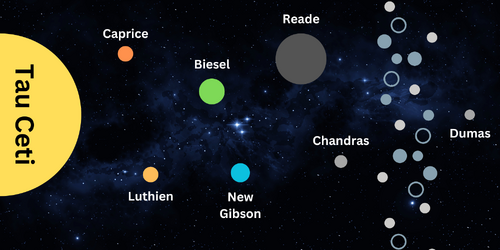
Tau Ceti is one of the most populous systems of humanity, located only twelve light years from Sol. It is the current capital system of the Republic of Biesel, and prior to 2462 was the only territory controlled by the Republic. It became independent from the Sol Alliance in 2452 as a result of the megacorporation NanoTrasen, and the monopoly it had on the precious resource known as phoron, which was discovered in the system itself.
Tau Ceti was first settled in 2147, after a colony ship touched down on the planet Biesel. From there, a base on the moon of Valkyrie was established, and significant colonization efforts also went underway on the planet of New Gibson. In the modern day, it is the richest system and one of two centers of trade in the Orion Spur, almost all of which can be attributed to the system having one of the largest deposits of Phoron in the known Spur within its Romanavich Cloud. Since the beginning of the scarcity however, these deposits have begun to dry up at an exponential rate, and the system has begun to face many issues(hyperlink to Republic of Biesel page, Scarcity section).
| Contents |
|---|
Planets and Major Bodies
Tau Ceti
The orbit of the star itself is one of the most heavily trafficked areas within human space, as it is where the massive Bluespace Ring present in the system is situated. There is a constant stream of incoming and outgoing traffic, all who pay a toll to the Republic, though sometimes they may not stay in the system for more than a few hours. That said, a vast majority do end up heading into the system itself, normally ending up in orbit of Biesel, New Gibson, or most commonly, Valkyrie.
Caprice (Tau Ceti I)
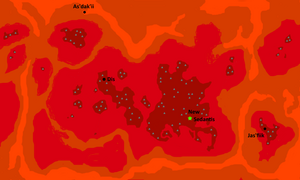
From the surface, Caprice is a scorching-hot volcanic planet in Tau Ceti. It is dotted with small research outposts and jagged artificial ravines, not unlike the innumerable near-identical mining colonies spread throughout the Spur. This surface appearance has, since the arrival of the Zo'ra Hive upon it a short decade ago, become deceptive and now hides Caprice's true nature. Anyone who dares to peel back and look beneath the folds of crust and bedrock finds not empty caverns and pits of magma but instead an immense subterranean metropolis of stone, steel, and flesh. Its Vaurcaesian design harkens back to the golden age of the Zo'rane Empire over Sedantis.
The Zo'ra, under High Queen Vaur and Queen Zoleth, have labored endlessly to turn what was only a short time ago an inhospitable wasteland into a true seat of not just her power but the new home of the Court of Queens to represent Vaurca across the Spur. It is from the newly ordained capital and seat of her throne, New Sedantis, that this mighty project began, but it certainly has not stopped there. Tunnels stretch all the way to the equally mighty Zo'rane fortress of Dis and even further beyond, deep towards the core. If the High Queen has her way, this construction has no plans to slow down anytime soon, phoron crisis or not.
Luthien (Tau Ceti II)
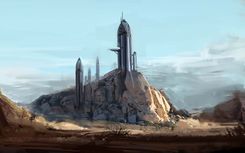
Luthien is a desert planet with a thin, unbreathable atmosphere of primarily nitrogen, and is not so much a colony as it is a factory. It is primarily home to Vaurcae from the brood of Xakt, Queen of Corpses, with most Workers being Bound Vaurcae. Some Unbound Vaurcae reside within the small settlements of human scientists and other interested parties that live upon the surface of the planet.
Luthien is the site of many testing and research facilities, such as those dedicated to weapons testing for the TCAF, or the development of flora and fauna that are able to adapt to extreme environments. Notably, k'ois is grown in select areas on the surface, far from the human-inhabited poles. Many areas of the desert planet can now be distinguished by their uncanny yellow sheen as the fungus grows just barely in control, twisting through and even under the dunes. While bouts of mycosis are uncommon, several high-profile incidents have led to some strife with the human populace and medical presence being on constant standby.
On the other hand, some research teams have found cooperation to be of value with the Zo'ra, allowing them to work in their laboratories scattered throughout the planet. Non-Vaurcae find that the Unbound can be relied on to keep secrets, and are invaluable for their VR and general scientific ability. The Au'takh of the Luthien Pact also work closely with the megacorporations, granting them a better quality of life than many of their kin elsewhere in the Republic - though at the cost of their prized freedom.
Biesel (Tau Ceti III)
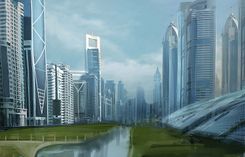
The third closest planet to Tau Ceti's star, Biesel is an Earth-like planet that benefits from a temperate climate and breathable atmosphere. Water represents 56% of the planet's surface.
Biesel is the most populous planet within the system, having many large cities and urban developments; it also serves as the capital planet for the Republic of Biesel. Environmental pollution remains low, primarily thanks to technologies developed during the phoronic revolution. The landmass of the planet itself is split into three massive continents, Astraeus, Selene and Eos; each hosting a multitude of cities and a continental capital. The capital of Biesel, and the Republic as a whole, is Mendell City, a megalopolis on the southern coast of the northern continent of Astraeus. The orbit around the planet is extremely crowded, with many multipurpose space stations, shipyards, and defense platforms in permanent orbit, and thousands of ships passing through a day, alongside tens of thousands of shuttles. In a high orbit around the planet is NanoTrasen's former Tau Ceti Branch Central Command Platform, the once NTCC Odin, recently renamed the SCCTCC Odin, alongside more stations than one can count.
Biesel is primarily a financial, phoronics, and agricultural centre, with most of its citizens working in its service industry, followed closely by the phoronics industry. Biesel has the most phoronics related industries of anywhere in the Spur, primarily centered on the formerly mineral rich continent of Eos. As the scarcity increases, more and more of this industry is shuttered, causing problems for the planet. Trade is also a major source of income, but a declining one, as the scarcity increases the costs of running operations. Tourism remains somewhat profitable, with visitors being drawn to Biesel's sprawling shopping centres and national parks alike.
The moon of Biesel, the Commonwealth of Valkyrie is a member-state of the Republic that contributes strongly to its economy through its status as a major shipping and trade port. Valkyrie's smaller mass means ships will use less fuel getting in and out of orbit compared to its parent planet. Goods from all over the Spur, legal and illegal, can be found in the twisting streets of Valkyrie, and it acts as a layover for many tourist vessels and trade ships moving across the galaxy. However, in recent years, it has developed a shadier reputation, as more and more illegal goods are smuggled through the port to be sold on Black Markets.
New Gibson (Tau Ceti IV)
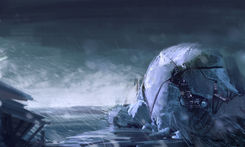
An ice covered world just outside the outer edge of the habitable zone, New Gibson is the industrial powerhouse of Tau Ceti, home to almost all of its manufacturing. As the atmosphere on New Gibson is too thin to support life, all of its population lives under biodomes.
The planet was a prime location for industrial development, since minimal terraforming was required, and populations of workers could be sustained in biodomes scattered across the barren landscape. Any activity on the planet's surface requires EVA equipment, but due to its high level of industrial development, the planet is the largest producer of consumer appliances, ship components, space station modules, and other manufactured goods in Tau Ceti. However it has very little phoronics industry, with most being on the planet of Biesel. Instead, there is a steady stream of supply ships running between Biesel and New Gibson, supplying Tau Ceti’s industrial center with all the processed phoron and phoron compounds it needs for manufacturing.
The planetary capital of New Gibson is the Hengsha Arcology, or simply Hengsha, a self-contained complex mimicking the landscape of Biesel, complete with parks, waterfalls and wildlife. While New Gibson has complex(s) dedicated to virtually all industries, its major players are advanced manufacturing with some wide-range manfacturing adjacent to its titanic planetary mines. In the cavernous pitfalls and valleys of New Gibson resides both its thriving mining economy - though the planet still must import many materials to meet manufacturing demands - and its greatest dangers.
Reade (Tau Ceti V)
Originally assumed to be a nondescript planet to 21st century astronomers, Reade defied expectations when early explorers found it to actually be a modestly sized gas giant. Its atmospheric composition mostly consists of hydrogen and helium, with heavier elements near the core. It takes 98 years for Reade to complete an orbit around the star, and has a few asteroid-sized moons.
Reade was previously most noteworthy for being the home of Anemostrovilos, a massive reinforced blimp holding a platform with a radius of 19 kilometers. The bio-dome city of Anemostrovilos is built on top of this platform, and a massive anchor keeps the entire structure steady as it floats in Reade's upper atmosphere. Its local economy was a mix of harvesting the gasses from Reade, as well as serving students of the Anemostrovilos College of Pioneers for decades.
However, since the independence of the system, Reade has slowly become the home of military shipbuilding in the Republic. While much of their pre-existing infrastructure was damaged during the attack on Biesel by the 35th Fleet, investments made by Hephaestus Industries - subsidized by a strategic diversification and economic relief program - have seen its military shipyards balloon in size. Recently, Hephaestus Industries completed work on the Republic Orbital Assembly Yards, an advanced military shipyard the likes of which the Republic has never had. As the budget for the TCAF only continues to increase, Reade only continues to see more business.
The colony is buffeted by intense storms every few years due to its rotations around the gas giant, and periodically faces traffic shut-downs for up to 3 days at a time at least once a year. It has recently been heavily fortified by the Tau Ceti Armed Forces, and the space around it has a significant military presence. While at one point Reade's orbit pirate activity enjoyed a massive spike and many unwary ships suffered, the increased strategic importance of Reade has seen the Republican Navy drive almost all but the most dedicated out of the inner system.
Chandras (Tau Ceti VI)
Chandras is an icy body in a distant orbit of Tau Ceti. Although its surface contains lakes of liquid nitrogen, it is entirely metal-deficient, and possessing no infrastructures to speak of, is uninhabited and of low interest for the system.
The Dust Belt
Past Chandras, the Dust Belt is a thick ring of debris encircling Tau Ceti's solar plane and enclosing its inner planets. Debris varies in size ranging from microscopic dust particles to large asteroids the size of small moons. In the early days of colonization the belt was once a hive of mining activity, but was mined out by 2390 to provide materials for the booming populations of Biesel and New Gibson. Now it is home to mothballed facilities, and rumored corporate blacksites.
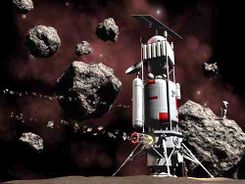
Dumas (Tau Ceti VII)
Dumas is an extremely small rocky body that orbits at the far reaches of Tau Ceti - obscured almost entirely from the inner system by the dust belt - with one of its defining features is an almost complete lack of light, resulting in surface temperatures nearing absolute zero. Since the formation of the TCAF, however, it has become one of the Republic’s largest military installations.
The Romanovich Cloud
The Romanovich Cloud is a shell of icy, rocky and metallic bodies on the very edge of Tau Ceti’s gravity well. The cloud is the largest known source of Phoron, and has been mined for over a century, providing over ninety-five percent of all the phoron used in the Spur outside of Elyra. It is under the complete control of NanoTrasen, keeping the corporation as one of the most powerful entities in the Orion Spur. The Romanovich Cloud is a hotbed for anomalous activity — which has only been steadily increasing as phoron deposits have dwindled.
Notable Locations
- NSS Aurora: founded in 2459 by NanoTrasen, the NSS Aurora is a station built to replace its eponymous predecessor. Situated in a phoron-rich asteroid, the Aurora was responsible for mining and researching the valuable mineral. Due to the importance of the Romanovich Cloud, the station was the site of important events related to Tau Ceti, including the latest Solarian invasion. The crew did not live on-site and commuted between the facility and the Odin during shifts. As phoron deposits began to dry up, the NSS Aurora's importance quickly diminished. A share of its crew was transferred to the SCCV Horizon. The station remains open and is mainly used to scrap whatever minerals are left in its foundations.
- Grand Romanovich Casino: opened in 2462, the Grand Romanovich is a Crevan-style casino floating in a touristic zone of the cloud. It was the first Adhomian casino to open in space. The Grand Romanovich has gambling spaces, a shooting range, a swimming pool, an indoor snowmobile circuit, a bar, a restaurant, and hotel rooms among its attractions. Despite the recent incidents - including deaths and two conspiracies - the establishment remains open thanks to its ties with Idris Incorporated. The Grand Romanovich has become a point of interest for those interested in the criminal and paranormal story of Tau Ceti.







